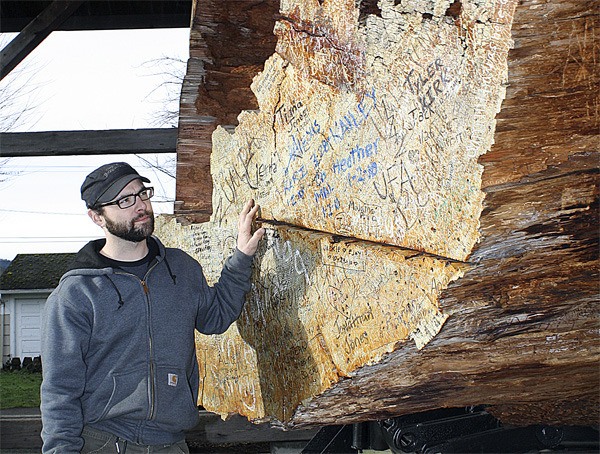The graffiti was only a few days old. “Charissa was here 1/18/11,” written in small, neat letters with permanent marker, was the newest marking on the surface of Snoqualmie’s 400-year-old Centennial Log. It was hardly the first and probably not the last to mar the once mighty, now vulnerable giant.
Nearly every square inch of open surface on the mammoth block of fir in downtown Snoqualmie’s Railroad Park is covered with graffiti tags—most in English, many in Spanish, one in Chinese. The log, one of the most visited tourist sites in the city, gets a new tag almost every other day.
If Caycee Furulie has his way, these kinds of mementos will be a thing of the past.
A handyman and self-described “green beret” troubleshooter for the Snoqualmie Parks Department, Furulie sat on the big log as a child. Today he is its chief protector, and battling graffiti is his neverending task.
“It’s the most important attraction in town, next to the depot,” Furulie said. “Everybody that drives by has to get their picture taken.”
The problem is, too many people do more than just take photos. Some visitors climb into the eroding hollow of the log to get their own picture taken. Others throw rocks at the softening wood.
“Kids will climb in it,” said Snoqualmie historian Dave Battey. The bark of the tree, which can burn like coal, is loose in places, and “is too easy to take home with you.”
Most vandals just write their name and the date of their visit. The urge to mark it is something Furulie has never understood.
“I used to pull over and yell, ‘Hey, respect the log!’” Furulie said. Now, with so much writing on it, he wonders whether such confrontations do any good.
Furulie sanded and refinished the log seven years ago, cleaning it up so that visitors could see its rings.
“Now, it looks exactly like it did when I refinished it,” he said.
The city has asked him to give it the works once again.
“I don’t want to do that until we put some sort of protection around it,” Furulie said.
Faced with the unending graffiti and steady erosion through vandalism, Furulie’s department plans to fence off the tourism magnet with a spiked, wrought-iron fence.
The barrier will permanently ring the entire log and its antique carriage. Furulie is reviewing bids for the project, which range from $4,500 to $20,000.
Furulie said an ornate fence is in keeping with the exhibit.
“It would remind me of going to a museum,” he said.
Tree’s history
A seedling in 1587, the original Centennial tree survived until the 1970s in a glade five miles north of the city.
Few such giants can be seen in the region today. Meadowbrook Farm, the space jointly preserved by the cities of Snoqualmie and North Bend, contains a huge cedar tree. Battey takes hikers to view another giant in the Asahel Curtis Nature Trail on Snoqualmie Pass.
Such trees must fight to reach their great size. They compete with shade-tolerant western red cedar, western hemlock and Sitka spruce. Eventually, some lucky fir trees win out and become giants. But time and gravity ultimately bring them down.
Surrounded by a logged forest, the tree that became the Centennial log was originally meant to be preserved in its native habitat. But then lightning struck the trunk and killed it, leaving a hundred-foot-tall snag.
According to former Snoqualmie Mayor Charles Peterson, foresters believed the dead tree posed a fire danger. A logging company took most of the trunk, but Peterson fought for a 26-foot-long, 39,000-pound section to be displayed at the entrance to the city.
Installed in 1977, the log was exposed to the elements until 1989, when a roof was added to protect it. By then, a lot of damage had already been done. The tree began rotting when it lost its top after being struck by lightning, and the decay was intensified by all the years in the rain.
Protected under its roof, lit by night, the log exhibit became a popular tourist attraction as well as a symbol of Snoqualmie’s fading logging industry. Battey said the log is a good compliment to the nearby Northwest Railway Museum, whose collection documents the region’s rail history.
Peterson, who was mayor when the log was brought to Snoqualmie, said the fence appears to be the best option.
“If we want to keep the log for any length of time, that’s the way to go,” he said. “I don’t know what else you can do. People just don’t respect property.”



